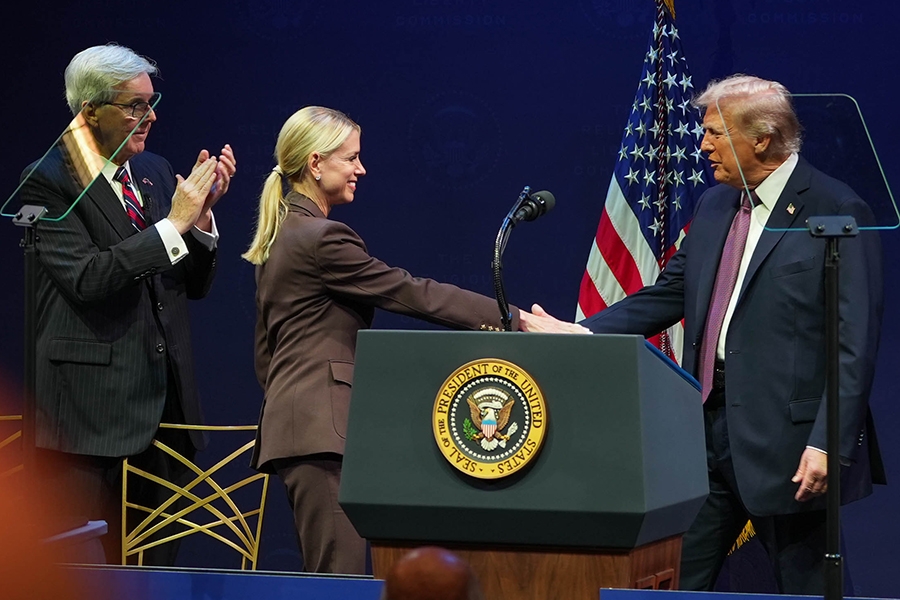 By Joseph Goldstein
Special to ProPublica
By Joseph Goldstein
Special to ProPublica
Judge Richard Owen of the U.S. District Court in Manhattan gathered a group of lawyers in his courtroom in 2007 to discuss the possible leak of sealed documents in a business case. As the hearing got under way, Owen, then 84, asked for someone to explain this newfangled mode of communication the lawyers kept mentioning — e-mail.
“It pops up in a machine in some administrative office, and is somebody there with a duty to take it around and give it to whoever it’s named to?” he asked.
Some of the lawyers figured that Owen, whose chambers came with a mimeograph machine when he became a judge in 1973, was just behind the times. Others wondered if the judge’s memory was failing him.
After all, the most famous case in his long career — the back-to-back trials of Silicon Valley investment banker Frank Quattrone — had revolved around a single e-mail. Yet he now acted as though this was the first he was hearing about it. “He didn’t understand what was happening in his own courtroom,” said one lawyer present that day.
Owen’s memory lapses popped up at critical moments. A month after his e-mail query, the judge stumbled badly when handing down a life sentence to drug dealer Darryl Henderson for his connection to a robbery crew that murdered three people in a Bronx apartment.
The prosecutor had previously called Henderson “the key into that apartment,” because Henderson was sleeping with the apartment’s female tenant and conceivably helped the murderers get past the front door. In Judge Owen’s mind, the metaphorical key became a literal key. He announced that the tenant had given Henderson “a key to get into that apartment,” and seemed unperturbed when the prosecutor explained there was no such evidence.
Then Owen expressed confusion over the relatively limited counts the jury had found Henderson guilty of and grew exasperated when the defense and prosecution tried to set him straight.
Lawyers questioned whether Owen’s mind was working well enough to be deciding matters of life and liberty. “Do I think age was a factor in some of his cloudy thinking? Yes,” said David Patton, a defense attorney for Henderson. “There were many times when he seemed confused and exhausted.” Owen declined repeated interview requests.
Life tenure, intended to foster judicial independence, has been a unique feature of the federal bench since the Constitution was ratified in 1789. Back then, the average American lived to be about 40 and the framers didn’t express much worry about senile judges. “A superannuated bench,” Alexander Hamilton said, is an “imaginary danger.”
No longer. Today, aging and dementia are the flip side of life tenure, with more and more judges staying on the bench into extreme old age. About 12 percent of the nation’s 1,200 sitting federal district and circuit judges are 80 years or older, according to a 2010 survey conducted by ProPublica.
Eleven federal judges over the age of 90 are hearing cases — compared with four just 20 years ago. (One judge, a Kansan appointed by President John F. Kennedy, is over 100.) The share of octogenarians and nonagenarians on the federal bench has doubled in the past 20 years. The demographics of the federal bench have no analogue on the state courts, where judges mostly occupy their office for a term of fixed years and generally have mandatory retirement ages, often in their 60s or 70s.
Scholars like David Garrow of Cambridge University have looked at senility on the Supreme Court and called for a reconsideration of life tenure for its justices. But on the lower federal courts, where judges still wield enormous power, the failings that come with age have gotten much less attention.
Sometimes, when judges stay on the bench longer than they should, no one questions their fitness. And most courts have no systemic way to deal with judges with age-related cognitive problems. “We are the worst fraternity in the world about this,” said Judge Boyce Martin, chief judge of the Cincinnati-based 6th Circuit Court of Appeals from 1996 to 2003.
For many older judges, no doubt, experience is a virtue. “My memory is not as acute as it was, [but] principles, I know, and my judgment is the same — it may be better,” said U.S. District Judge Jack Weinstein, a Brooklyn legend at 89 and one of the nation’s most respected legal minds.
But judges of advanced years are clearly at increased risk for trouble with memory and cognition. According to the Alzheimer’s Association, about 13 percent of Americans over 65 have Alzheimer’s and nearly half of those 85 and older develop it or suffer from dementia.
The judiciary does not assess the competence of its senior judges. The courts have no formal policy requiring, or even recommending, that judges receive medical checkups or consult with geriatricians. Instead, the institution relies on other judges to monitor colleagues, and, working discreetly behind the scenes, to push out enfeebled judges gently.
Judge Dee Benson of U.S. District Court in Utah, age 62, likened the process to persuading an elderly parent to stop driving: “How are we going to get grandma off the highway?”
Chief Judge Frank Easterbrook is considered the most aggressive in monitoring judicial colleagues as they age.
Chief Judge Frank Easterbrook is considered the most aggressive in monitoring judicial colleagues as they age.
The judge who patrols that highway most aggressively is Frank Easterbrook, chief of the Chicago-based 7th Circuit U.S. Court of Appeals. In the last four years, Easterbrook says, he has arranged for two colleagues to see neurologists.
One was diagnosed with Alzheimer’s and retired. The other insisted on returning to the bench after a stroke, but because he had difficulties “with executive function,” Easterbrook said, he removed all criminal cases from the judge’s docket. Easterbrook has even publicly called on lawyers to contact his chambers directly if they think a judge is exhibiting symptoms of dementia — a rare move by the bench to enlist the public in monitoring judges.
Why do judges outstay their welcome? Longer life spans and attachment to the job play a role. Another factor, judges and experts say, is that in some ways the job has gotten easier.
Until the 1930s, district and circuit court judges functioned without law clerks. Now even district court judges get two apiece, and they can pick up the slack as a judge’s output diminishes. A 2005 study offers a sense of just how long judges are holding on: More than nine out of 10 district court judges die within a year of retiring fully.
“I can’t remember a judge who went home to clip roses,” said Bill Dazey, a longtime assistant federal defender in Indianapolis. “I just feel better working,” explained 94-year-old Judge Robert McWilliams of the Denver-based 10th Circuit. “You can’t just sit around the house watching TV.”
And for nearly a century, Congress has invited judges to work less, starting at age 65, instead of retiring. A judge who goes on senior status, as the arrangement is called, still draws a salary and works as much or as little as he or she likes; meanwhile, the president can nominate a new judge to the take the spot the senior-status judge has vacated, at least on paper. It’s a system meant to encourage elderly judges to make room for younger ones, without giving anybody the boot.
There’s no question that the arrangement aids the smooth functioning of the judiciary. Senior judges provide the extra manpower needed to keep the federal docket moving, especially at times when the president and Senate are slow to fill vacancies on the bench. (At present, 101 seats are empty, a relatively high number). In 2008, judges with senior status handled more than 18 percent of the caseload in the federal trial courts, double the portion they handled a generation ago.
But the work-as-you-wish arrangement also insulates judges from normal retirement pressures and enables senior-status judges to stick around even if they are too enfeebled to do the entire job. Some senior-status judges, for instance, only hear cases that can be decided entirely on written motions — like social security or habeas petitions — which don’t require the exertion of presiding over a courtroom or the risk of public scrutiny. Judge Owen now decides cases only in this way.
In a similar fashion, the 94-year-old Judge McWilliams generally leaves the heavy lifting to others on the three-judge panels he is a part of. For the most part, he has stopped writing precedential opinions, limiting himself to issuing short orders in less significant cases.
Judges facing age-related mental decline are prone to make rookie mistakes that harm the rights of the people before them. Judge John Shabaz of the federal court in Madison, Wisc., had a reputation as a strict sentencer who resolved cases at a brisk pace. But when he reached his mid-70s, attorneys began to suspect his mind was deteriorating. “He had trouble reading things out loud, such as plea agreements,” lawyer David Mandell says. “He would start and stop and start over.”
In August 2006, before announcing a 20-year sentence, Shabaz forgot to offer a convicted drug dealer the chance to ask for mercy, a right spelled out in the Federal Rules of Criminal Procedure. The judge reversed the process, first announcing the sentence and then offering the man a chance to speak.
The U.S. Court of Appeals for the 7th Circuit called this “the kind of error that undermines the fairness of the judicial process” and sent the case back to a different judge for a do-over. A story about Shabaz appeared in the Capital Times, a Madison newspaper, under the headline “Confusion in the Court.” Easterbrook, playing his role as highway patrolman, sent intermediaries to persuade Shabaz not to return from a medical leave for shoulder surgery in 2008. For a while Shabaz resisted, but eventually he acquiesced, a colleague said. He assumed senior status in January 2009 and no longer hears cases.
Sometimes the problem isn’t as clear-cut as forgetfulness — a failing that, after all, is relatively easy to recognize. Attorneys say J. Thomas Greene, a U.S. district judge in Utah, seemed to grow more impulsive with age, a common sign that the brain’s ability to self-censor is eroding.
In 2006, Greene, then 76, presided over the trial of a man charged with lying about the disappearance of a teenage girl. At a proceeding to pick a jury, the judge asked prospective jurors whether they were acquainted, a question meant to keep friends from serving on the same panel. One man answered that he knew one of the other potential jurors, a woman. “I didn’t recognize you,” the woman exclaimed.
“She didn’t recognize you with your clothes on,” Greene shot back, shocking the courtroom.
Another impulsive outburst affected the sentence of a serial bank robber. “Maybe I’m a fool to have given you this kind of break twice, but somehow I have a feeling about you,” Greene said, before sentencing the man to less than half the prison time called for in the federal sentencing guidelines. The appeals court threw out the sentence in a decision expressing concern that Greene hadn’t taken the case seriously enough. Greene stopped hearing cases in 2008.
How common are such lapses? One answer comes from an experiment by the 9th Circuit. In 2001, the appeals court set up a confidential help line for judges, expecting most calls to be about depression or addiction. Instead, the overwhelming majority have come from judges concerned that elderly colleagues were showing signs of slipping, said Richard Carlton, the consultant who answers the line. He said that each year he receives calls about six to eight judges within the circuit whose “mental acuity or change in temperament, or other changes in behavior are troubling.”
Beyond the help line, and the informal pressure of chief judges, the more formal remedies have little effect. The last impeachment for mental incapacity was in 1803. Judges also can be stripped of their dockets if a committee of their peers votes to issue a certificate of disability. That has happened just twice in the last 20 years. Fewer than 1 percent of the 5,277 complaints from litigants and lawyers against judges, filed from 2000 to 2005, involved allegations of mental disability. Generally protective of the bench and fearful of a backlash, lawyers rarely complain.
Without clear rules or a protocol to guide them, some judges initiate their own early-warning system, asking colleagues or a former clerk to let them know if they are slipping. Judge Weinstein of Brooklyn gets an annual neurological checkup, including a CAT scan. In an interview, he suggested that the judiciary should consider amending its ethical code to encourage judges to notify their chief judge about health concerns, particularly if they are taking medications that affect memory or emotional balance.
Judge Martin of the 6th Circuit would go further: He thinks regular mental and physical checkups for senior-status judges should be required. “Shouldn’t you take that extra step of letting the government make sure you’re as agile as you thought you were?” he asked.
Karen Williams knows firsthand what it means for a judge to face mental decline. While she doesn’t support mandatory testing, she said she wouldn’t object to a guideline that encouraged judges to consider regular exams. Named to the 4th Circuit at age 40, Williams was seen as a rising star, possibly even a Supreme Court candidate, until 2009. That’s when she began to notice changes in herself. She struggled with spacial distortion. Even in familiar places, she couldn’t remember which way to turn when she left a room. Stunningly, at age 57, Williams was diagnosed with Alzheimer’s.
There was no roadmap for what to do next. Could she continue working until her symptoms worsened? For how long? “I questioned how and who would determine when I reached the stage that my mental processes truly were affected to such a degree as to make me unfit to remain on the bench,” she said in a written response to my questions in the most detailed public account she has given about her diagnosis. “Would it require daily, weekly, monthly testing? What kind of testing? What test result would be needed to equate with ‘unfitness’?”
Though she still felt able to perform her duties, after reflection Williams decided to retire immediately. “It was inappropriate to continue working, knowing that at any time any opinions I wrote or joined could be challenged or second-guessed,” she told me. She added that she “did not want to harm in any way the dignity of the court.” Without rules or a policy to guide her decision, Williams had to make her own call. She decided to put the court first. But she may be more the exception than the rule.
Joseph Goldstein is a freelance reporter in New York.
ProPublica intern Joseph Kokenge contributed to this report.





